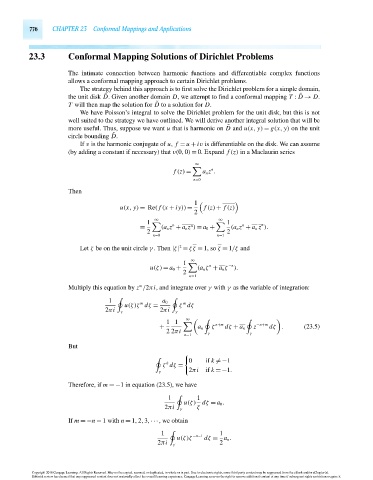Page 796 - Advanced_Engineering_Mathematics o'neil
P. 796
776 CHAPTER 23 Conformal Mappings and Applications
23.3 Conformal Mapping Solutions of Dirichlet Problems
The intimate connection between harmonic functions and differentiable complex functions
allows a conformal mapping approach to certain Dirichlet problems.
The strategy behind this approach is to first solve the Dirichlet problem for a simple domain,
˜
the unit disk D. Given another domain D, we attempt to find a conformal mapping T : D → D.
˜
˜
T will then map the solution for D to a solution for D.
We have Poisson’s integral to solve the Dirichlet problem for the unit disk, but this is not
well suited to the strategy we have outlined. We will derive another integral solution that will be
more useful. Thus, suppose we want u that is harmonic on D and u(x, y) = g(x, y) on the unit
˜
˜
circle bounding D.
If v is the harmonic conjugate of u, f = u + iv is differentiable on the disk. We can assume
(by adding a constant if necessary) that v(0,0) = 0. Expand f (z) in a Maclaurin series
∞
n
f (z) = a n z .
n=0
Then
1
u(x, y) = Re( f (x + iy)) = f (z) + f (z)
2
∞ ∞
1 n 1 n n
n
= (a n z + a n z ) = a 0 + (a n z + a n z ).
2 2
n=0 n=1
2
Let ζ be on the unit circle γ . Then |ζ| = ζζ = 1, so ζ = 1/ζ and
∞
1
−n
n
u(ζ) = a 0 + (a n ζ + a n ζ ).
2
n=1
m
Multiply this equation by z /2πi, and integrate over γ with γ as the variable of integration:
1 m a 0 m
u(ζ)ζ dζ = ζ dζ
2πi γ 2πi γ
1 1
∞
+ a n ζ n+m dζ + a n z −n+m dζ . (23.5)
2 2πi
n=1 γ γ
But
0 if k =−1
k
ζ dζ =
2πi if k =−1.
γ
Therefore, if m =−1 in equation (23.5), we have
1 1
u(ζ) dζ = a 0 .
2πi γ ζ
If m =−n − 1 with n = 1,2,3,···, we obtain
1 1
u(ζ)ζ −n−1 dζ = a n .
2πi γ 2
Copyright 2010 Cengage Learning. All Rights Reserved. May not be copied, scanned, or duplicated, in whole or in part. Due to electronic rights, some third party content may be suppressed from the eBook and/or eChapter(s).
Editorial review has deemed that any suppressed content does not materially affect the overall learning experience. Cengage Learning reserves the right to remove additional content at any time if subsequent rights restrictions require it.
October 14, 2010 15:39 THM/NEIL Page-776 27410_23_ch23_p751-788

